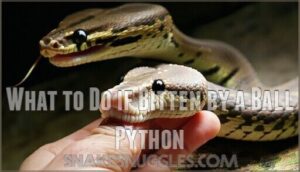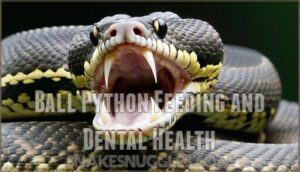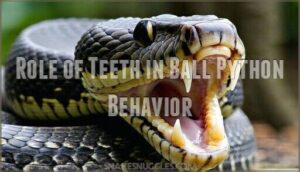This site is supported by our readers. We may earn a commission, at no cost to you, if you purchase through links.

These aren’t venomous fangs – they’re designed like tiny fishhooks to grip prey securely. Your typical ball python has roughly 20-30 teeth per row across four rows, with the upper jaw housing about 60-80 teeth and the lower jaw containing 20-40 smaller ones.
Think of them as nature’s own velcro system, perfectly engineered for their constrictor lifestyle. These curved daggers constantly shed and replace themselves throughout the snake’s life, ensuring they stay sharp for catching dinner.
Understanding exactly how these teeth work reveals some fascinating secrets about snake behavior and safety.
Table Of Contents
- Key Takeaways
- How Many Teeth Do Ball Pythons Have?
- Are Ball Pythons Venomous?
- Unique Ball Python Oral Adaptations
- Ball Python Bite Force and Strength
- Preventing Ball Python Bites
- What to Do if Bitten by a Ball Python
- Ball Python Feeding and Dental Health
- Ball Python Tooth Loss and Replacement
- Dental Care for Ball Pythons in Captivity
- Ball Python Oral Anatomy and Evolution
- Frequently Asked Questions (FAQs)
- Do ball pythons have two rows of teeth?
- How many teeth did python have?
- How to get a ball python to release its bite?
- How many teeth does a ball python have?
- Are ball pythons toothless?
- What happens if a ball python loses a tooth?
- Do Baby Ball pythons have smaller teeth?
- How many teeth do ball pythons have?
- Do snakes have 200 teeth?
- How often do 2 year old ball pythons eat?
- Conclusion
Key Takeaways
- You’ll discover ball pythons pack around 100-150 razor-sharp teeth arranged in six rows that work like nature’s velcro system to grip prey securely.
- Your ball python’s teeth aren’t venomous fangs but mechanical tools that constantly shed and replace themselves throughout the snake’s lifetime, ensuring they stay sharp for feeding.
- You can prevent bites by reading your snake’s body language, using proper handling techniques, and recognizing stress signals like defensive coiling or rapid breathing.
- You’ll need to monitor your python’s dental health through proper prey sizing, consistent feeding schedules, and watching for signs like difficulty eating or mouth infections that require veterinary care.
How Many Teeth Do Ball Pythons Have?
You’ll discover that ball pythons pack quite the dental arsenal with over 100 needle-sharp teeth arranged in six rows across their upper and lower jaws.
These curved, backward-pointing teeth aren’t just for show—they’re perfectly designed to grip prey during feeding and get replaced throughout the snake’s lifetime, which is a remarkable example of dental arsenal.
Ball Python Tooth Anatomy
Understanding ball python tooth structure starts with knowing these snakes pack around 25 to 35 ball python teeth in each jaw. That’s over 100 needle-sharp weapons total! These aren’t your typical straight teeth – they’re curved backward like tiny fishing hooks, perfectly designed for their hunting lifestyle.
The python dental structure features four rows on top and two on bottom, creating a grip that’d make a vice jealous. Each tooth measures roughly 1/8 to 1/4 inch long, hollow for lightweight strength.
This reptile teeth anatomy showcases nature’s engineering at its finest. Tooth function goes beyond just holding prey – these curved daggers prevent escape during constriction.
The jaw mechanics work with powerful muscles to guide food down their throat. Thanks to polyphyodonty (continuous tooth replacement), your ball python’s dental health stays sharp throughout life.
Lost a tooth while feeding? No worries – another’s already growing to replace it, ensuring their snake dentition stays effective.
Teeth Shed and Replacement
Your ball python’s tooth loss might surprise you—it happens more often than you’d think! This natural shedding process keeps their dental health in top shape through polyphyodonty.
Here’s what makes snake tooth replacement fascinating:
- Replacement rate occurs continuously throughout their lifetime
- Tooth regrowth happens quickly, ensuring no gaps in their arsenal
- Snake teeth structure allows seamless shedding without affecting feeding
- Dental health remains vital as new teeth are always developing
Don’t panic if you notice missing teeth—snake tooth shedding is perfectly normal as long as your python keeps eating well. Understanding ball python teeth is essential for maintaining their overall health and well-being.
Teeth in Upper and Lower Jaws
Now that you understand tooth replacement happens continuously, let’s explore the specific jaw alignment and tooth structure across ball python mouths.
You’ll find approximately 100-150 snake teeth arranged in staggered rows – four rows in the upper jaw and two in the lower jaw. This tooth count varies by age and size, with larger pythons typically having more teeth than smaller ones.
Snake teeth types in ball pythons are uniform – all curved, needle-like structures measuring roughly 1/4 inch long.
These python teeth facts highlight their specialized design:
- Dental health relies on this multi-row arrangement for secure prey grip
- Upper jaw teeth are slightly longer than lower jaw teeth for better anchoring
- Ball python mouth structure allows teeth to work like tiny fishhooks
- Teeth in snakes point backward, making escape impossible once prey is caught
This strategic tooth replacement system guarantees your python always maintains superior hunting capability.
Are Ball Pythons Venomous?
You might wonder if those sharp, curved teeth deliver venom when a ball python bites.
Ball pythons are completely non-venomous constrictors that rely on their powerful muscles to squeeze prey, not toxic bites to subdue their meals, using their powerful muscles to constrict.
Ball Python Teeth Characteristics
Sharp-eyed predators, ball pythons pack around 150 needle-like teeth measuring roughly 1 centimeter each.
These hooked weapons curve backward, creating a natural trap for unsuspecting prey.
Unlike venomous cousins, ball python teeth facts reveal they’re purely mechanical – no poison delivery system here.
Their snake dentition features acrodont attachment, meaning teeth anchor directly to jawbone without sockets, making tooth replacement a continuous process throughout their lives.
Ball Pythons as Constrictors
You’re looking at nature’s ultimate squeeze artist. Ball pythons rely on Constriction Techniques rather than venom to subdue their meals. These nonvenomous snake teeth work alongside powerful muscles in coordinated Hunting Tactics.
Here’s how their Prey Capture system works:
- Python jaw flexibility allows them to grip struggling prey while coiling
- Constrictor Methods cut off blood flow, not just breathing
- Ball python teeth anchor victims during the deadly embrace
Their Snake Behavior revolves around patience and precision, making them masters of mechanical advantage over chemical weapons.
Swallowing Prey Whole
After constriction methods subdue prey, you’ll witness an impressive swallowing mechanism.
The ball python anatomy includes flexible jaw joints that unhinge, allowing their snake oral cavity to expand dramatically.
These constrictor teeth hook backward, guiding prey headfirst through the swallowing process.
The feeding mechanics work like a ratchet system—once prey enters, there’s no escape.
Their digestion systems then break down whole animals over several days, maximizing nutritional efficiency.
Unique Ball Python Oral Adaptations
Beyond their impressive collection of 100+ needle-sharp teeth, ball pythons possess remarkable oral adaptations that make them efficient hunters.
You’ll find these snakes equipped with flexible quadrate bones that allow their jaws to unhinge dramatically, heat-sensing pores to detect warm-blooded prey, and forked tongues that work like chemical detectors to track scents through the air.
Quadrate Bone for Wide Jaw Opening
The quadrate bone serves as ball python anatomy’s secret weapon for incredible jaw movement.
This specialized bone structure acts like a hinge, allowing wide opening that doubles their mouth capacity.
Through sophisticated jaw mechanics, the quadrate function enables your snake to consume prey twice their head size.
This snake oral cavity adaptation showcases how snake teeth count works alongside flexible jaw structure for survival.
Heat-sensing Pores
While jaw expansion helps ball pythons consume large prey, their heat-sensing pores provide another incredible advantage.
These specialized pit organs along their lips detect infrared radiation, giving your snake thermal vision that works like night-vision goggles for hunting.
Here’s how these heat sensors function:
- Infrared detection – Pores sense temperature differences as small as 0.003°C
- Thermal mapping – Creates heat images of warm-blooded prey in darkness
- Pore function – Works alongside ball python anatomy for precise strikes
Tongue for Smell
Your ball python’s forked tongue works like nature’s chemistry set, flicking out to collect airborne particles and chemical signals.
This snake olfaction system transfers scent molecules to the Jacobson’s organ, creating a detailed map of prey trails and environmental cues.
While heat-sensing pores detect warmth, the olfactory system provides chemical detection that’s equally important for hunting success in python anatomy.
Ball Python Bite Force and Strength
You’ll be surprised to learn that those curved, needle-sharp teeth pack more punch than you’d expect from a snake that’s often considered docile.
A ball python’s bite force increases with their size, and those backward-angled teeth create an incredibly effective grip that makes escape nearly impossible for their prey, utilizing their backward-angled teeth.
Holding Prey With Curved, Sharp Teeth
Imagine this: your ball python’s mouth is basically nature’s version of a high-tech security system. Those curved, sharp teeth work like tiny grappling hooks, creating an unbreakable tooth grip during prey capture.
Here’s how their constriction method works:
- Recurved teeth angle backward like fishing barbs, preventing escape once they bite
- Jaw mechanics allow wide opening to accommodate prey larger than their head
- Sharp teeth penetrate skin instantly, anchoring the snake during strikes
Ball python teeth aren’t just for show—they’re precision tools. Each tooth in their reptile dental formula serves a specific purpose in snake tooth anatomy. These constrictor snakes rely on their snake teeth function to secure meals before their powerful body coils take over. It’s like having built-in handcuffs that never let go.
Bite Power Proportional to Size
Think of a ball python’s jaw as a hydraulic press that gets stronger with age.
Your snake’s bite force increases dramatically with size, following predictable scaling patterns.
Adult ball pythons can deliver 26-40 N of force, while hatchlings manage only 6-10 N.
This jaw strength directly correlates with body mass and muscle development.
Larger pythons need more constriction power to subdue tougher prey like adult rats.
Their tooth structure and bite force work together as an efficient prey-capture system, making size a vital factor in hunting success.
Bite Force
Tooth Sharpness
Head Size
Importance of Teeth in Feeding
Understanding tooth function reveals why ball python teeth are feeding powerhouses. These backward-curved tools don’t just bite—they’re precision instruments for prey capture and constriction method success.
Snake dental anatomy serves four critical purposes:
- Anchoring prey during initial strikes
- Guiding victims down the throat smoothly
- Preventing escape with razor-sharp hooks
- Supporting jaw movement for whole-prey swallowing
Without proper tooth structure, your python couldn’t execute its signature feeding mechanics effectively.
Preventing Ball Python Bites
You’ll want to prevent ball python bites by understanding their behavior and recognizing when they’re stressed or defensive.
Learning proper handling techniques and reading your snake’s body language can help you avoid those sharp, curved teeth altogether, by recognizing the signs of stress and defensive behavior.
Understanding Ball Python Behavior
Your ball python’s body language speaks volumes about their comfort level.
These snakes communicate through subtle behavioral patterns that reveal their emotional state and habitat needs.
| Behavior | Meaning |
|---|---|
| Tongue flicking | Gathering scent information |
| S-shaped coiling | Defensive posture when stressed |
| Balling up | Ultimate protection response |
Snake communication involves environmental enrichment cues you can read.
Social interaction isn’t their forte, but understanding snake biology helps prevent defensive reactions and promotes healthier ball python characteristics.
Proper temperature gradient management is essential for maintaining a healthy and stress-free environment for your ball python.
Recognizing Signs of Stress
Recognizing stress signals early prevents bites and keeps you safe.
Watch for defensive coiling, rapid breathing, or aggressive striking motions. Your snake’s body language tells the whole story – tense muscles, frantic tongue flicking, and attempts to hide signal discomfort.
Environmental factors like temperature changes or loud noises trigger these reactions, making proper observation essential for successful snake handling.
Monitoring reptile stress levels using stress monitor tools can help identify potential issues before they escalate.
Proper Handling Techniques
Once you spot stress signals, your handling techniques determine whether you’ll avoid those 25-35 sharp teeth.
Master these snake safety basics for successful bite prevention:
- Use a calm approach with slow movements – sudden gestures trigger defensive strikes
- Maintain a secure grip behind the head and support the body weight
- Practice gentle touch during regular interaction to build trust
Snake handling success comes from reading snake behavior and respecting your ball python’s boundaries.
What to Do if Bitten by a Ball Python
Getting bitten by a ball python isn’t the end of the world, but you’ll want to handle it properly to avoid complications.
While their 100+ tiny teeth might feel like pinpricks, proper first aid and wound care will keep you safe and healthy.
First Aid for Ball Python Bites
Ball python bites feel like sharp pinpricks but aren’t dangerous.
Stay calm and don’t pull away – this worsens the bite wound. Once released, wash with warm water and soap for proper wound care. Apply antibiotic cream and cover with a sterile bandage.
These snake bites rarely break skin, making first aid straightforward. Clean thoroughly to prevent infection since snake bite treatment focuses on wound cleaning rather than venom concerns.
Understanding bite prevention methods is essential for safe handling and minimizing the risk of bites.
Seeking Medical Attention
While ball python bites aren’t medical emergencies, don’t ignore them completely.
Snake bite treatment starts with basic first aid, but watch for signs of infection over the next few days.
If you notice increased redness, swelling, or pus, contact your doctor for proper wound care guidance.
Most snake bite first aid situations resolve quickly, but your emergency response should include monitoring for complications requiring professional snake bite medical attention.
Cleaning and Disinfecting Wounds
You’ll want to act fast when dealing with snake bite wound cleaning to prevent complications. Proper wound care and infection prevention are essential for safe healing.
- First Aid: Immediately wash the bite area with warm, soapy water to remove bacteria and debris from the puncture wounds.
- Disinfecting Methods: Apply rubbing alcohol or hydrogen peroxide, then use antibiotic ointment to create a protective barrier against infection.
- Infection Control: Cover with a sterile bandage and monitor for redness, swelling, or unusual pain that might signal trouble brewing.
Ball Python Feeding and Dental Health
Your ball python’s feeding routine and dental health go hand in hand, since those 100+ curved teeth work hard during every meal.
Proper prey sizing, consistent feeding schedules, and watching for dental problems will keep your snake’s mouth healthy and ready for action, which is crucial for its overall dental health.
Ideal Prey Size Ratio
Now that you’ve learned how to handle a ball python bite, let’s talk about keeping your snake healthy through proper feeding. Getting prey size right prevents dental issues and digestive problems.
Ball pythons need prey matching their widest body diameter – not larger than 1.5x their width. This keeps their teeth working properly during constriction methods.
| Snake Size | Prey Type | Width Ratio |
|---|---|---|
| Hatchling | Pinky mice | 1:1 match |
| Juvenile | Fuzzy mice | 1:1 match |
| Adult | Small rats | 1:1 match |
Proper prey selection supports snake nutrition while preventing regurgitation and tooth damage during feeding habits.
Feeding Schedule and Frequency
Once you’ve determined the right prey size, establishing consistent feeding times becomes your next priority.
Young ball pythons need meal frequency every 5-7 days, while adults thrive on bi-weekly schedules. Their slow digestion rate means patience pays off.
Here’s what makes feeding schedules work:
- Consistency builds trust – your snake learns when food’s coming
- Proper timing prevents stress – hungry snakes get defensive
- Regular meals support healthy shedding – well-fed pythons shed cleanly
- Scheduled feeding reduces handling bites – predictable routines calm anxious snakes
Monitoring for Dental Issues
Beyond feeding schedules, you’ll want to keep an eye on your snake’s dental health. Regular mouth inspections help catch problems early – think of it as a snake smile check.
| Warning Signs | What to Watch For |
|---|---|
| Physical Issues | Dental fractures, jaw alignment problems, tooth decay |
| Health Problems | Gum disease, tooth infection, excessive tooth loss |
| Behavioral Changes | Difficulty eating, reluctance to strike prey |
Spotting these dental issues early prevents bigger oral health complications down the road. Understanding ball python health is essential for maintaining a healthy pet snake.
Ball Python Tooth Loss and Replacement
You’ll notice your ball python occasionally loses teeth during feeding or handling, which is completely normal since they’re designed to shed and regrow throughout their lifetime.
This natural replacement process guarantees your snake always has sharp, functional teeth for catching prey, with new ones growing back within weeks of being lost, ensuring they always have sharp teeth.
Normal Tooth Shedding Process
Throughout their lives, ball pythons continuously shed and replace teeth like tiny dental conveyor belts.
This natural tooth replacement process keeps their curved grippers razor-sharp for catching prey.
Snake tooth shedding happens regularly – old teeth fall out while new ones grow in their place.
It’s perfectly normal reptile dental health maintenance that guarantees your python’s tooth regrowth stays on track for effective feeding.
Causes of Excessive Tooth Loss
Tooth decay and gum disease top the list when your ball python’s teeth start falling out like autumn leaves.
Poor diet lacking essential nutrients weakens their jaw bones, making teeth wobble loose. Jaw injury from striking cage walls or force-feeding creates tooth fractures that lead to loss.
Bacterial infections turn gums into swollen, painful messes that can’t hold teeth properly. Chronic dehydration dries out mouth tissues, while dirty cages expose your snake to harmful bacteria.
Snake tooth loss accelerates when calcium deficiencies meet oral trauma—it’s like a perfect storm for snake dental health problems requiring immediate attention.
Veterinary Care for Dental Problems
If your ball python faces serious dental problems, you’ll need veterinary care from an exotic reptile specialist. These professionals can handle everything from routine dental x-rays to complex dental surgery for severe tooth infections or gum disease. They’ll also check jaw alignment and overall snake oral health.
Here are three important tips:
- Schedule annual vet checkups to catch any issues early
- Provide a balanced diet and clean, warm environment to support dental health
- Avoid handling your snake too much during shedding periods to prevent accidental tooth breakage
Reptile veterinary care differs substantially from regular pet care. Exotic vets understand snake tooth problems and can extract loose teeth, treat oral inflammation, and prescribe appropriate medications. Don’t wait if you notice persistent bleeding, swelling, or feeding difficulties – early intervention prevents minor issues from becoming major snake dental health problems.
Dental Care for Ball Pythons in Captivity
While your ball python’s teeth naturally shed and replace themselves, you’ll want to keep an eye on their dental health through proper feeding and regular checkups.
A nutritious diet of appropriately-sized prey helps maintain strong teeth, and watching for signs like difficulty eating or mouth rot guarantees any problems get caught early, which is crucial for maintaining your pet’s overall dental health.
Importance of Proper Diet
Your ball python’s dental health depends heavily on what you feed it. A ball python diet with proper Nutrient Balance keeps teeth strong and healthy.
Food Variety isn’t needed—stick to appropriately-sized rodents that match your snake’s midsection width. Meal Frequency matters: juveniles eat weekly, adults every 1-2 weeks.
This Feeding Guidelines approach prevents nutritional deficiencies that compromise snake dental health and supports natural snake tooth growth. Proper python food sources Ball Python Food are essential for a healthy diet.
| Dietary Needs | Impact on Teeth |
|---|---|
| Proper prey size | Promotes natural wear |
| Regular feeding | Maintains jaw strength |
| Quality nutrition | Supports tooth replacement |
| Consistent schedule | Prevents stress-related issues |
Preventative Dental Checkups
Most snake owners don’t realize their pet needs dental checkups. Regular veterinary oral exams help catch tooth decay and gum health issues before they become serious problems.
Your reptile vet should perform:
- Visual inspection of teeth alignment and condition
- Assessment of jaw mobility and bite mechanics
- Evaluation for signs of infection or abnormal wear
While snake dentists aren’t common, exotic vets trained in snake dental care can spot problems early. You can even find specialized dental products for reptiles. Some cases may require dental X-rays to check root health beneath the surface.
Signs of Dental Disease
Vigilant owners can spot dental disease early by watching their snake’s behavior and mouth appearance. Ball python dental health issues like stomatitis and snake mouth infections show distinct warning signs.
Watch for these four critical indicators:
- Mouth ulcers or open sores along the gumline
- Swollen gums with yellow-white pus discharge
- Missing teeth or loose, discolored dental structures
- Difficulty eating with prey dropping or refusal
Excessive saliva, foul breath, and persistent mouth gaping signal advancing snake oral health issues. Early intervention prevents serious complications.
Ball Python Oral Anatomy and Evolution
You’ll discover that ball pythons haven’t changed much from their wild ancestors, keeping the same 100+ curved teeth that helped them survive for millions of years.
These dental adaptations work perfectly whether your python lives in the African grasslands or your living room terrarium, and are a key example of how ball pythons haven’t changed much from their wild ancestors.
Comparison to Wild Counterparts
When you compare captive and wild ball pythons, the differences in dental anatomy and hunting methods become clear.
Wild pythons develop sharper, more robust teeth through constant prey capture, while captive teeth may be less worn from softer feeding routines.
Wild diet variations also influence snake tooth structure – natural prey creates stronger snake tooth function than pre-killed rodents, showing fascinating evolutionary changes.
Adaptations for Survival
Extraordinary adaptations make you appreciate how ball pythons thrive in their environment.
Their recurved teeth work alongside jaw flexibility for constriction hunting, while sensory adaptations like heat-sensing pits detect prey in darkness.
Scalation provides perfect camouflage against predators and prey alike.
These dental anatomy features aren’t just about snake tooth structure—they’re survival tools.
- Curved teeth and flexible jaws enable secure prey capture during constriction hunting
- Heat-sensing capabilities allow detection of warm-blooded animals in complete darkness
- Camouflaged scalation patterns provide protection from predators while ambushing prey
Role of Teeth in Ball Python Behavior
Your ball python’s teeth aren’t just for show—they’re behavioral game-changers.
These backward-curved tools excel at prey manipulation and constriction aid, gripping victims while your snake wraps around them.
The swallowing mechanism relies on teeth guiding food down their throat.
Bite reflexes kick in during feeding, and their teeth provide sensory input about prey size.
Understanding ball python behavior helps explain why snake feeding habits depend heavily on these specialized dental tools.
Frequently Asked Questions (FAQs)
Do ball pythons have two rows of teeth?
No, ball pythons don’t have just two rows of teeth.
You’ll find they’ve six rows total – four on their upper jaw and two on their lower jaw, containing approximately 25-35 sharp, backward-curved teeth.
How many teeth did python have?
Unlike their venomous cousins who sport just two fangs, ball pythons pack around 100-150 needle-sharp teeth arranged in multiple rows.
You’ll find these backward-curving grippers perfectly designed for snagging prey, not chewing it, which highlights their unique adaptation for snagging.
How to get a ball python to release its bite?
Stay calm and don’t pull away—this makes the bite worse.
Remain still and wait patiently; your python will naturally release on its own.
Gently pour cold water over its head to encourage faster release if needed.
How many teeth does a ball python have?
Here’s your needle-sharp truth: you’ll find approximately 100-150 teeth lurking in that ball python’s mouth!
They’re arranged in six rows—four on top, two below—and they’re constantly replacing themselves throughout the snake’s lifetime.
Are ball pythons toothless?
No, ball pythons aren’t toothless at all.
They’ve got around 100-150 small, curved teeth arranged in multiple rows.
These needle-sharp teeth help them grab and hold prey during feeding, though they’re not venomous fangs.
What happens if a ball python loses a tooth?
When your python loses a tooth, don’t worry—it’s completely normal and happens regularly during feeding or handling.
The tooth will regrow quickly thanks to their natural replacement system, so it won’t affect their eating habits, which is a completely normal process.
Do Baby Ball pythons have smaller teeth?
Yes, baby ball pythons have smaller teeth than adults.
Their teeth measure about 1/8 inch compared to adult teeth of 1/4 inch.
As juveniles grow, they’ll shed these smaller teeth and replace them with larger ones suited for bigger prey.
How many teeth do ball pythons have?
Like a treasure trove hidden in their jaws, ball pythons pack around 100-150 needle-sharp teeth arranged in six rows.
You’ll find four rows on top and two below, with each tooth curved backward to grip prey securely during feeding, utilizing their needle-sharp teeth.
Do snakes have 200 teeth?
Most snakes don’t have 200 teeth, but it varies widely by species.
You’ll find ball pythons have around 100-150 teeth, while some larger snakes can have more.
Each species has evolved different tooth counts based on their hunting and feeding needs.
How often do 2 year old ball pythons eat?
Getting your 2-year-old ball python on a feeding schedule? You’ll want to offer appropriately-sized prey every 7-10 days. Juvenile pythons need more frequent meals than adults to support their growth.
Conclusion
Knowledge is power when you understand how many teeth do ball pythons have and their function.
These remarkable reptiles use their 100+ razor-sharp, backward-curving teeth as nature’s perfect gripping system rather than weapons.
You’ll find their dental setup fascinating – four rows of constantly replacing teeth that work like tiny fishhooks.
Whether you’re a current owner or considering adoption, understanding their tooth structure helps you appreciate these gentle constrictors while handling them safely and confidently, with their gripping system.



















